Two instances of special petroglyph manifestations in Namibia (Twyfelfontein Valley) and Peru (Virú Valley), having very limited visibility, will be discussed in this paper.
Dos casos de manifestaciones especiales de petroglifos en Namibia (Valle de Twyfelfontein) y Perú (Valle de Virú), que demuestran de tener una visibilidad muy limitada, serán discutidos en este documento.
by Maarten van Hoek
Maarten van Hoek – rockart@home.nl
Reflecting (on) Petroglyphs: Two Cases
*
ABSTRACT: Two instances of special petroglyph manifestations will be discussed in this paper. Those two petroglyph panels, one in the Twyfelfontein Valley, Namibia, and the other in the Virú Valley, Peru, prove to have very limited visibility. For that reason the petroglyph panel from the Virú Valley escaped being noticed, although the example from the Twyfelfontein Valley is known from at least 1975.
RESUMEN: Dos casos de manifestaciones especiales de petroglifos serán discutidos en este documento. Estos dos paneles de petroglifos, uno en el Valle de Twyfelfontein, Namibia, y la otra en el Valle de Virú, Perú, demuestran de tener una visibilidad muy limitada. Por eso el panel con petroglifos en el Valle de Virú no ha sido registrado previamente, aunque en el ejemplo en el Valle de Twyfelfontein es conocido desde al menos 1975.
*
Introduction
It will be no surprise that in order to study rock art one has to be able to see the images. Unfortunately taphonomic logic dictates that many rock art images are no longer visible. Importantly, what is left can only be seen by the naked eye through reflection of visible light. In the case of petroglyphs, mainly the contrast in reflection determines the degree of visibility of those rock art images. This paper focuses on a unique type of petroglyphs that only become visible when reflecting light perceived from one specific angle only reveals the image.
Visibility of Petroglyphs
Usually petroglyphs are visible because of the contrast between image and the natural rock surface. The level of this contrast may be the result of several factors. Petroglyphs are mainly executed on the patinated surface of a rock, which in most cases results in a fresh (often whitish) mark. Because of this result the prehistoric manufacturer often chose rock surfaces that are dark of colour (for instance black, brown or red) to make the image stand out more clearly. Unfortunately, over time patination blurs the difference in colour and in the end the mark has the same patination as the natural rock surface and becomes less visible (Figure 1) or even invisible. Then only the depth of the mark may reveal the pattern (disregarding the use of several modern techniques here, like laser technology). The depth of the mark can then be enhanced by slanting sunlight. To summarise, there are two general manifestations of petroglyphs, although often petroglyphs are (better) visible because of a mixture of both manifestations.
Figure 1. Petroglyphs from the Chicama Valley, northern Peru, showing the colour differentiation between rather freshly made markings and deeply patinated markings. Photograph copyright by Maarten van Hoek.
The first manifestation concerns petroglyphs with a certain depth (anthropic grooves and anthropic cavities) that are visible because of slanting (sun)light. Although in some instances the grooves are so deep that they are visible in very dull weather (for instance at Palancho, Argentina: video), slanting sunlight is especially effective when there is hardly any or no colour differentiation between superficially executed petroglyphs and the rock surface. In such cases the darker (shaded) grooves contrast strongly with the natural rock surface that reflects (often much) more light (for instance at Banda Florida, Argentina: video). In this case the shaded (darker) groove may be regarded to have negative reflection, while the (brighter) natural surface has a positive reflection. Negative reflection only means that in these cases the reflection of light from the petroglyph is less intense or less bright than the light reflected by the natural rock surface (thus the terms negative and positive only serve to indicate the contrast). In such cases the angle of the sunlight determines the contrast as is shown by two photographs of the same petroglyphs on a rock panel from the Majes Valley, southern Peru (Figures 2 and 3).
Figure 2. Petroglyphs from the Majes Valley, southern Peru, with slanting sunlight from the (upper) right revealing more details in the bird petroglyph. Photograph copyright by Maarten van Hoek.
Figure 3. The same petroglyphs from the Majes Valley, southern Peru, with slanting sunlight from the (upper) left revealing more details in the anthropomorphic petroglyph. Photograph copyright by Maarten van Hoek.
The second manifestation concerns images that are (only) visible because of colour distinction. Contrasting colours are especially useful when the images have been executed very superficially. Although I know of darker (for instance bluish or blackish) petroglyphs on a brighter rock surface, I would like to depart from the standard situation that petroglyphs appear brighter than the surrounding rock surface. Very superficially pecked (and unpatinated) petroglyphs will thus be clearly visible. In such instances the clearly visible petroglyph will be referred to here as having a positive reflection, while the natural rock surface will be regarded to have a negative reflection. In this case positive reflection only means that the reflection of light from the petroglyph is more intense or brighter than the darker natural surface (notice that the terms ‘positive’ and ‘negative’ have now been reversed). Fine examples of the second manifestation are found in the Jequetepeque Valley in the north of Peru (Figure 4).
Figure 4. Petroglyphs from the Jequetepeque Valley, northern Peru, clearly visible because the contrast between positive (images) and negative (natural rock surface) reflection. Photograph copyright by Maarten van Hoek.
Especially when the colour contrast is less distinct, the image is often blurred by direct, perpendicular light of the sun (in contrast to slanting sunlight). In that case it is often useful to artificially cast a shadow over the petroglyph so that the colour differentiation stands out more clearly. This is illustrated with a petroglyph from the Ingenio Valley, central Peru (Figure 5). The artificially shaded boulder reveals the petroglyph much better (Figure 6).
Figure 5. Petroglyph from the Ingenio Valley, central Peru, almost invisible because of the negative effect of the direct sunlight striking the boulder. Photograph copyright by Maarten van Hoek.
Figure 6. The same petroglyph from the Ingenio Valley, central Peru, much better visible because of the positive effect of the artificially created shadow. Photograph copyright by Maarten van Hoek.
Petroglyphs that are very superficially executed and that are (almost) as heavily patinated as the natural rock surface may still stand out because of differences in reflection. In such cases the petroglyph may have a negative reflection or a positive reflection. An example will clarify the negative reflection of a petroglyph. The petroglyph site of Parque Diaguita (video) mainly comprises deeply patinated black boulders that heavily reflect sunlight. However, when overcast there is no direct sunlight and the difference between the images and the natural rock surface is minimal (Figure 7). In contrast, when direct sunlight hits the rock at a certain angle, the reflection from natural rock surface is very bright, thus having a positive reflection, while the darker petroglyphs stand out clearly visible (Figure 8). In these cases the petroglyphs have a negative reflection (reflect less light).
Figure 7. Petroglyphs from Parque Diaguita, western Argentina, almost invisible during dull weather because the much patinated character of both the natural rock surface and the petroglyphs. Photograph copyright by Maarten van Hoek.
Figure 8. The same petroglyphs from Parque Diaguita, western Argentina, much better visible because the contrast caused by the reflection of direct sunlight. Photograph copyright by Maarten van Hoek.
However, there are very rare instances of petroglyphs that have a positive reflection, even when there is little or no difference between the patination of the petroglyph and the natural rock surface and when the petroglyph has no (measurable) depth. This means that the petroglyph will be invisible when observed from the wrong angle or when the source of light is too faint to reflect the image (even when standing in a favourable position in case the sun were shining). Only when standing at the correct position in relation with a strong enough source of light (in most cases the sun) the petroglyph will show up. Thus also the orientation and the degree of the slope of the rock surface play an important role. I will now discuss two sites with petroglyphs that possess unique instances of petroglyphs that are only visible because of an unanticipated positive reflection: the Twyfelfontein Valley in Namibia and the Virú Valley in Peru, both found in arid deserts.
*
The Twyfelfontein Valley
Twyfelfontein in NW Namibia no doubt is one of Africa’s most important rock art concentrations with a large number of sites found in an area of about 13 km across (NW-SE). Although there are several panels with rock paintings, most rock art images are petroglyphs that have been pecked out of the red sandstone. In most cases the petroglyphs are rather well visible because of contrasting colours, while in other cases the images show up due to slanting sunlight. There are also several petroglyphs that are extremely faint because of ongoing weathering and patination. Three, possibly four petroglyphs (on three boulders) are interesting in the discussion of petroglyphs with a positive reflection. All three boulders are found rather close together, just below the west facing escarpment of the SE Plateau at Twyfelfontein (and photographs of all three boulders – and many more – feature in my second video about Twyfelfontein ).
On the eastern edge of a level, rock free area there is a jumble of large rock blocks and slabs of red sandstone. On one such large slab, sloping 40° to the south, there is one of Twyfelfontein’s best-known images, often referred to as the ‘Dancing Kudu’, also called ‘Das Fabeltier’ by Ernst Scherz (1975). The very superficially executed kudu petroglyph has been abraded to a very smooth polish. A disc motif in front of the kudu appears even more superficially polished. This is a most unusual technique for San petroglyphs. Those two petroglyphs are best observed from the south when the sun (which is in the north at the southern hemisphere) reflects the polished surfaces (Figure 9). However, those two petroglyphs are also visible without direct sunlight (more faintly though) because of contrasting colours and because the ‘kudu’ petroglyph has some measurable depth.
Figure 9. The polished ‘Dancing Kudu’, polished disc, clearly visible because of the contrast caused by the reflecting sunlight. Twyfelfontein, Namibia. Photograph copyright by Maarten van Hoek.
Another slab at Twyfelfontein with a very smooth upper surface also slopes slightly to the south. It has several rows of small cupules and some large pecked (concentric) rings and grooves. The northern top of the slab has a brighter area that reflects the light of the sun differently than the surrounding area of the natural rock surface. It seems that this part has very faintly been bruised in order to create an image or images. However the pattern is rather confusing. With some imagination one can distinguish the neck of a giraffe (yellow arrow in Figure 10) and its head (orange arrow in Figure 10), and (south of the purported giraffe) a bird (red arrow in Figure 10) in the brighter areas. Although it is by no means certain that this bright area is anthropic and now only visible with positive reflection, a nearby boulder provides evidence that the phenomenon of positive reflection definitely occurs at Twyfelfontein, though uniquely.
Figure 10. Petroglyph panel showing pecked motifs and cupules and a large area that has possibly been bruised in order to create images. Twyfelfontein, Namibia. Photograph copyright by Maarten van Hoek.
On a large plate of sandstone near a small stream, which (only in wet times) runs down from the plateau and then plunges over the escarpment to join the north flowing major stream of Twyfelfontein Valley, are some petroglyphs. The slab has a smooth and flat upper surface that gently slopes towards the south. Unfortunately the surface is damaged by natural erosion and large parts have exfoliated. The most ‘conspicuous’ petroglyph on this boulder is called ‘Das Riesentier’ by Ernst Scherz (1975: 177) and only because of the long neck it is identifiable as a giraffe. However, today the petroglyph is only visible when the position of the sun is favourable in relation to the observer, thus when observed at a specific angle, catching the reflection of the sun from the petroglyph (Figure 11).
Figure 11. The polished ‘Riesentier’, clearly visible because of the contrast caused by the reflecting sunlight. Twyfelfontein, Namibia. Photograph copyright by Maarten van Hoek.
This phenomenon was noted in 1975 by Ernst Scherz who describes the petroglyph as follows: “Die Reste einer sehr großen Giraffe. Vom hintern Hinterbein bis zum Schwanzansatz 115 cm. Sie ist nicht in den Stein geschlagen, sondern ihm nur aufgeschliffen. Am besten sieht man das Tier spiegelnd gegen die Sonne. Ein Höhenunterschied ist an den Außenkanten nicht festzustellen, weder zu sehen, noch zu fühlen. Doch fühlt man deutlich die Glätte der polierten Fläche. Kein Patinaunterschied gegenüber dem unbearbeiteten Stein. Es ist erstaunlich, dass die Politur der Oberfläche die lange Zeit der Patinierung überdauerte“.
Freely translated this text reads: “The remains of a very large giraffe. From the hind leg to the base of the tail the image measures 115 cm. The image is not made by pecking into the stone; the surface of the image has only been polished. At best, you can see the animal reflecting against the sun. At the margins of the image a difference in depth cannot be established; neither can it be seen, or felt. But, you will clearly feel the smoothness of the polished surface. There is no difference in patina between the image and the natural rock surface. It is amazing that the polished image endured the patination process for such a long time“.
To the right of the giraffe are several pecked (concentric) circles of rather large dimensions, similar to those on Rock 3. Also two petroglyphs depicting ostriches have been reported, but they are invisible in the photograph due to the specific angle with which the photo had been taken.
This slab is located rather near the spring at Twyfelfontein, which provided the focus for the settlement. Even though on the opposite side of the valley there is a large seasonal waterfall and the Hauß River (2 km to the NW), these are temporary, while the spring is permanent, though slow. It is unknown if there is a specific relationship between the polished giraffe petroglyph and the spring.
*
The Virú Valley
The Virú Valley (located in the Department of La Libertad) houses one of the many major rock art concentrations in the coastal area of northern Peru. An east-west stretching section of this valley has a large number of (only) petroglyph sites that are distributed over an area of about 14 km across. The area has been inhabited and occupied by many succeeding societies and most of those peoples left their marks on stone, while also numerous temples, houses, ancient roads and burials are found at many places. Almost every petroglyph in this area has been executed by rather superficially pecking or bruising the stone, removing only a thin layer of the (often deeply patinated) surfaces of boulders and outcrops. Thus, most petroglyphs are visible because of contrasting colours, even when overcast. Only in a few cases slanting sunlight is useful in order to see some patterns better. However, the petroglyphs of at least one panel are only visible when the sun is shining and, what is more, only from a specific observation point (Figure 12).
Figure 12. The original photograph of the snake petroglyph panel, faintly visible because of the contrast caused by the reflecting sunlight. Virú Valley, Peru. Photograph copyright by Maarten van Hoek.
As usual there are many more boulders and outcrops in this valley without any petroglyphs and thus it is no surprise this particular stone with petroglyphs has been overlooked by previous rock art researchers and archaeologists. To my knowledge this stone has not been reported by previous researchers. For instance, the petroglyphs on this specific stone are not illustrated or described in the (very incomplete) inventory by Antonio Núñez Jiménez (1986: 453 – 492) and also archaeologist Daniel Castillo Benites from Trujillo – who is currently carrying out a survey of the rock art of the Departments of La Libertad and Cajamarca – does not mention this special stone. Having visited the area frequently, I only noticed the petroglyphs on this stone for the first time in 2012.
I passed this stone during both overcast and sunny weather but I never noticed the images. This oversight is caused by the fact that the petroglyphs are only visible when direct sunlight is reflected by the very superficially bruised images and the panel is observed from one specific position. Therefore, only one time – when the sun is in the right position in relation with the sloping surface of the stone and the observer – one is able to see and photograph the petroglyphs. Moving away from that (momentarily!) auspicious observation spot for less than half a metre immediately resulted in the images to become invisible.
I have not touched the stone, but I could not distinguish any relief between the images and the natural surface of the stone. Also, when moving away only a very short distance from the positive observation spot, I could not see any difference in patination. Especially the shape of the largest petroglyph ruled out the possibility of the shape being some natural staining (which sometimes occurs on this type of stone). The images are definitely anthropic petroglyphs.
The reflected images on the panel revealed, though faintly, a rather broad and fully bruised (thus not outlined or deepened) anthropic serpentine-shape and some smaller, even fainter patterns. When digitally enhanced the petroglyphs show up better (Figures 13 and 14). Unlike the images at Twyfelfontein, the petroglyphs on this stone have not been polished. The serpentine figure – depicted as seen from above – seems to end in a large and fully bruised triangular head, which often is a characteristic feature of snake imagery in Andean rock art. I estimate the snake petroglyph to measure about 80 cm in across (not following the zigzag). Above the snake is a much smaller bruised oval-shaped ‘line’, while below the snake – ‘embraced’ by the zigzagging body of the snake – are two bruised shapes that just possibly may depict birds in profile. However, except for the snake image, all other images are most ambiguous and their layout in Figure 15 is tentative.
Figure 13. The digitally enhanced photograph of the same petroglyph panel. Virú Valley, Peru. Photograph copyright by Maarten van Hoek.
Figure 14. A more strongly enhanced photograph of the same petroglyph panel. Virú Valley, Peru. Photograph copyright by Maarten van Hoek.
Figure 15. The same panel with the petroglyphs marked in a different colour. Virú Valley, Peru. Photograph and additions copyright by Maarten van Hoek.
*
Conclusions
It proves that certain petroglyphs can only be revealed by reflecting light when observing the petroglyph panel from just one specific angle. Only the specific and relative combination of the positions of the sun, the (inclination of the) rock art panel and the observer sometimes reveals those ‘hidden’ petroglyphs.
In case of the Twyfelfontein polished giraffe I tend to regard the petroglyph as highly intentional because of the carefully polished nature of the petroglyph. If this is the case, one may wonder why not more similarly polished petroglyphs occur at Twyfelfontein (and elsewhere in southern Africa). Importantly, one must realise that – when just having been executed – the giraffe must have had a completely unpatinated character and must have been visible from many more angles, even in overcast weather. Thus, the layout and polished nature of the giraffe petroglyph will be intentional in every respect, but the visual effect in the present time must be regarded to be just coincidence.
The case of the Virú Valley stone is different as the major petroglyph is not polished, but only very superficially bruised (and yet it survived the destructive forces of nature). It may therefore represent an abandoned attempt to manufacture petroglyphs. However, also in this case the attempt to create the petroglyphs is intentional and will have resulted in clearly visible patterns at the very time of manufacture. But again it is highly questionable whether the extremely limited visibility of today is intentional.
In any case, it proves advantageous to conscientiously scrutinise any petroglyph panel for ‘hidden’ images, but also to examine seemingly undecorated rock surfaces. Therefore I recommend trained archaeologists to also observe rock art panels especially with the intention of searching for ‘hidden’ – positively reflecting – petroglyphs. Finally, I would be grateful if any reader, who is aware of similar situations anywhere-else – involving positive-reflection petroglyphs – would contact me.
Bibliography
Núñez Jiménez, A. 1986. Petroglifos del Perú. Panorama mundial del arte rupestre. 2da. Ed. PNUD-UNESCO – Proyecto Regional de Patrimonio Cultural y Desarrollo, La Habana.
Scherz, E. R. 1975. Felsbilder in Südwest-Afrika, Teil II: Die Gravierungen im Nordwesten Südwest-Afrikas. Köln-Wien.
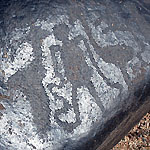
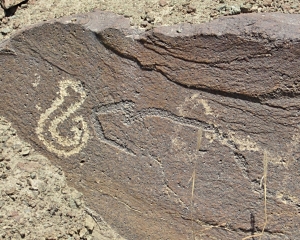
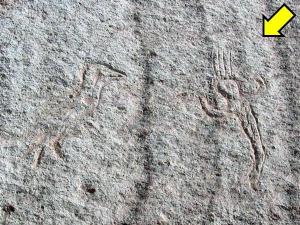
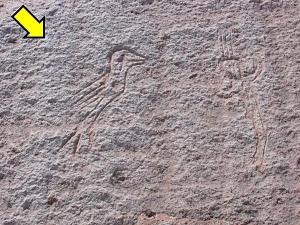
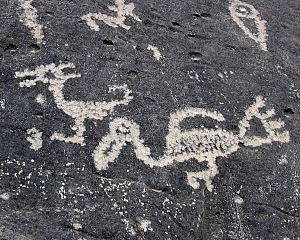
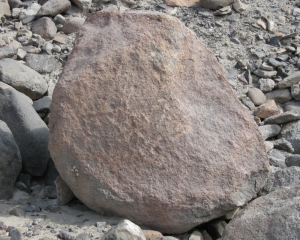
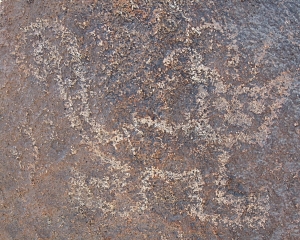
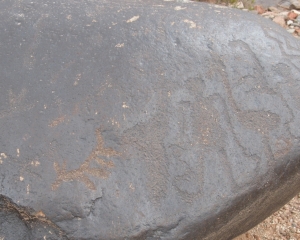
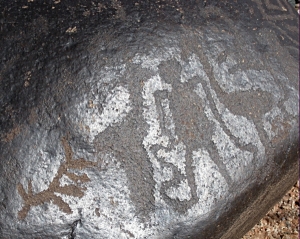
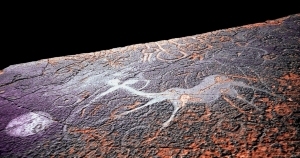
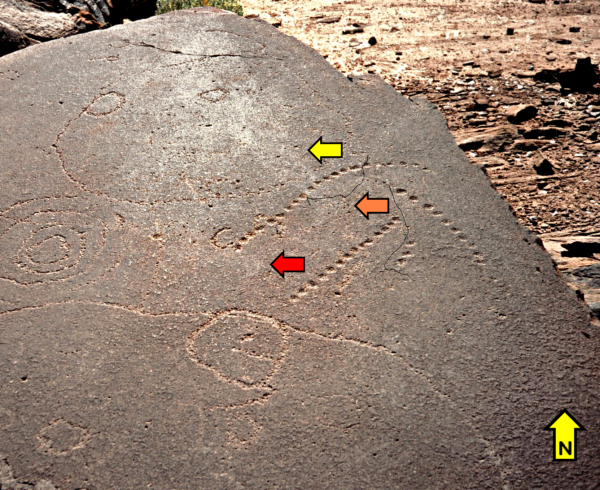
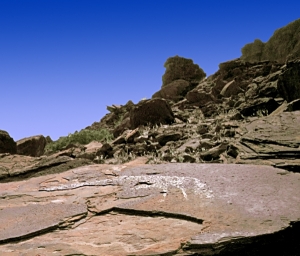
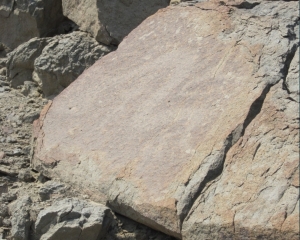
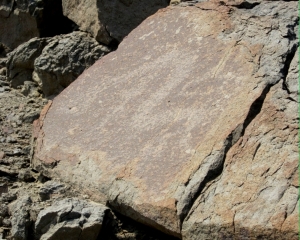
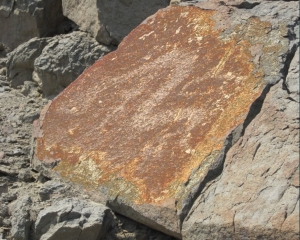
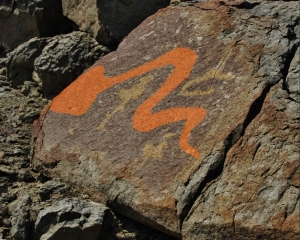
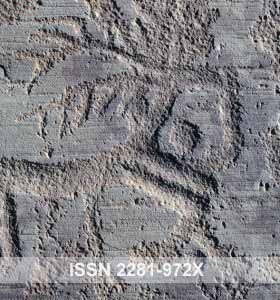













Leave a Reply